| Back Number | No.15 2005/05/11 | |||
| News | May Exhibits at the NGO Global Village |  |
||
| Pavilions : Africa Pavilion | ||||
| Interview | Miguel Ruiz-Cabañas (Mexico) Mexican Commissioner General of EXPO 2005 Aichi, Japan |
|||
| Column | Civic Project: “How to Love the Earth” | |||
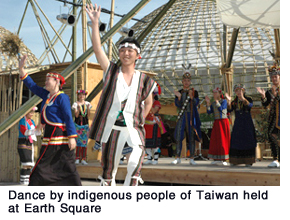 There are five pavilions made of bamboo housing the exhibits of NPOs and NGOs at the NGO Global Village. Japanese and overseas organizations join hands here to create each exhibition unit. Five such units per month that comprise a total of 30 units will be participating at EXPO 2005 and unfolding exhibits and experience-based workshops focused around the pavilions that will enable visitors to learn while having fun.
There are five pavilions made of bamboo housing the exhibits of NPOs and NGOs at the NGO Global Village. Japanese and overseas organizations join hands here to create each exhibition unit. Five such units per month that comprise a total of 30 units will be participating at EXPO 2005 and unfolding exhibits and experience-based workshops focused around the pavilions that will enable visitors to learn while having fun.A change of NPO/NGO exhibitors here was made on May 1. Those exhibiting in May are: “Hall of Reviving the Human Spirit through Prayer” hosted by the World Conference of Religions for Peace Japanese Committee; “Energy Square of Light and Water” hosted by the Renewable Energy Promoting People’s Forum; “Acorn Forest, Baobab Forest” hosted by the Acorn Club; “Let’s Talk with Children” hosted by the Child Abuse Prevention Network Aichi; and “Saving Mothers’ Lives Hall,” hosted by Japanese Organization for International Cooperation in Family Planning. The exhibits at the five pavilions opened on May 1 after a sleepless night of preparations. The Hall of Reviving the Human Spirit through Prayer is a pavilion that aims to realize a peaceful world in which humankind and nature coexist by resurrecting the spirit that people used to have in respect of life and the grandeur of nature. An opening ceremony was held on May 1 at Earth Square at the center of the zone with religious leaders of the world present. A dance by indigenous people of Taiwan dedicated to the Earth and other events were held. |
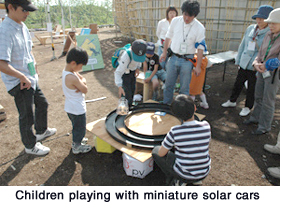 At Energy Square of Light and Water, 22 organizations from Japan and abroad are introducing the utilization of natural energy such as solar and wind power. In addition to panel board and miniature model displays at the plaza located by the pavilion, there is also an area where visitors can experience life that utilizes natural energy, such as the operation of solar cars and solar cooking for making popcorn and other items.
At Energy Square of Light and Water, 22 organizations from Japan and abroad are introducing the utilization of natural energy such as solar and wind power. In addition to panel board and miniature model displays at the plaza located by the pavilion, there is also an area where visitors can experience life that utilizes natural energy, such as the operation of solar cars and solar cooking for making popcorn and other items. Acorn Forest, Baobab Forest is a pavilion where three domestic organizations that are conducting afforestation activities and an organization from Madagascar, Africa are exhibiting. Four staff members from Madagascar are participating. On the day of our visit, the four were actively demonstrating the production of local woodwork, introducing local circumstances in Japanese, etc. |
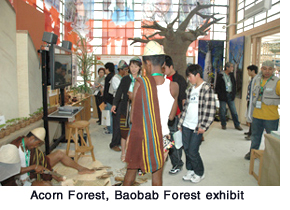 The Let’s Talk with Children pavilion is being exhibited by a Japanese organization for the prevention of child abuse together with a UK organization that has been conducting such activities for over 100 years. Here, families were viewing picture-story shows or expressing various emotions, such as anger and sadness, through drawings. It is said to be a program where families can experience conversing naturally or expressing their sincere feelings. One of the appeals of this pavilion is that visitors can listen directly to valuable overseas experiences by staff members participating from the UK.
The Let’s Talk with Children pavilion is being exhibited by a Japanese organization for the prevention of child abuse together with a UK organization that has been conducting such activities for over 100 years. Here, families were viewing picture-story shows or expressing various emotions, such as anger and sadness, through drawings. It is said to be a program where families can experience conversing naturally or expressing their sincere feelings. One of the appeals of this pavilion is that visitors can listen directly to valuable overseas experiences by staff members participating from the UK.Finally, Saving Mothers’ Lives Hall introduces, through panel boards, footage and actual birthing kits, the lives of women in developing countries as well as the activities of people working to protect the health of local villagers. A young woman who saw this exhibit said that she was deeply affected when she learned that the lives of many women in Africa were lost because of the lack of minimal healthcare kits. She said that she was struck by the message that the lives of two people - a mother and her child - could be saved by just 500 yen (about USD 5). Planned in June and beyond at the NGO Global Village are more interesting exhibits, including actual antipersonnel land mines (with explosives removed) at the Get Rid of Anti-Personnel Landmines Hall that will enable visitors to come in direct contact with global circumstances. For details please visit the NGO Global Village website. |
![]()
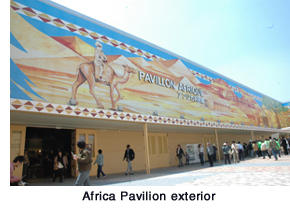 The Africa Pavilion is located in Global Common 5 close to the Nagakute Area’s West Gate. The overall exhibition space of this joint pavilion of 28 African nations is roughly 3,500 square meters. The exhibit spaces correspond, in north to south order, of exhibiting African countries. If you start at the Egypt Pavilion situated adjacent to the Africa Pavilion, visit each of the exhibit spaces at the Africa Pavilion, then go to the South Africa Pavilion, you will have traveled the length of Africa at EXPO 2005 Aichi, Japan.
The Africa Pavilion is located in Global Common 5 close to the Nagakute Area’s West Gate. The overall exhibition space of this joint pavilion of 28 African nations is roughly 3,500 square meters. The exhibit spaces correspond, in north to south order, of exhibiting African countries. If you start at the Egypt Pavilion situated adjacent to the Africa Pavilion, visit each of the exhibit spaces at the Africa Pavilion, then go to the South Africa Pavilion, you will have traveled the length of Africa at EXPO 2005 Aichi, Japan.The theme of this joint pavilion is “African epic.” Africa is one of the cradles of civilization, and it is an important area that enables us to learn about the origins of humankind. The appeal of the Africa Pavilion is, without question, that visitors can be exposed, in one pavilion, to the grandeur of the continent’s nature as well as the culture and lifestyles of the people living in Africa’s natural environment. |
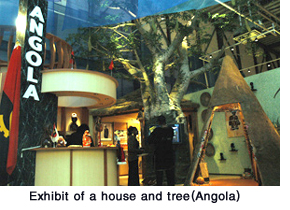 If you want to get to know about Africa as the cradle of the human race, begin by going to the exhibit of replicas, displayed at the Symbol Zone situated at the center of the joint pavilion, of what are said to be the oldest known fossilized skulls, from a village called Herto, of modern humans. Discovered in Ethiopia in 1997, experts consider these remains to be of primitive modern humans from about 160,000 years ago and important materials that back up the theory that modern humans originated in Africa and spread to other parts of the world. Furthermore, ‘Lucy,’ a 3.5 million year-old fossil of a female hominid is also a must-see. Discovered in 1974, the replica of the fairly complete skeletal remains of this Australopithecus afarensis was transported to Japan for exhibit at EXPO 2005 Aichi, Japan. Neighboring Kenya is also exhibiting various specimens, etc. of manlike apes and the human species that show the evolution of humankind, which date back to 25 million years ago.
If you want to get to know about Africa as the cradle of the human race, begin by going to the exhibit of replicas, displayed at the Symbol Zone situated at the center of the joint pavilion, of what are said to be the oldest known fossilized skulls, from a village called Herto, of modern humans. Discovered in Ethiopia in 1997, experts consider these remains to be of primitive modern humans from about 160,000 years ago and important materials that back up the theory that modern humans originated in Africa and spread to other parts of the world. Furthermore, ‘Lucy,’ a 3.5 million year-old fossil of a female hominid is also a must-see. Discovered in 1974, the replica of the fairly complete skeletal remains of this Australopithecus afarensis was transported to Japan for exhibit at EXPO 2005 Aichi, Japan. Neighboring Kenya is also exhibiting various specimens, etc. of manlike apes and the human species that show the evolution of humankind, which date back to 25 million years ago. For those who want to come in contact with the nature of Africa - the wide variety of flora and fauna of the continent, also known as the Animal Kingdom - it should be enjoyable to see the exhibits of the countries of Africa, with its diverse range of climates, tropical rainforests savannas and deserts. Each country is utilizing specimens, models, video footage, etc. and is displaying ingenuity in introducing their country’s nature, plants and animals. Madagascar, the treasurehouse of rare wild species; Gabon, the country of the tropical rainforest; and various other countries are exhibiting many items that you may only be able to see at EXPO 2005. If you want to learn about the daily lives of the people of Africa, go into the Mauritanian exhibit. It is a tent of the nomads living in the desert where you can see the wisdom of living, such as a natural refrigerator utilizing the body of an animal. It might be fun to imagine what it is like to live in Sudan through a city mock-up containing miniatures of people and cute animals recreating a scene in the daily lives of the people. The Africa pavilion is a goldmine for those with an interest in handcrafts. The masterfulness of the woodwork of Mali and Burundi is a sight to behold, while you may be surprised by the Ugandan garments made of tree bark. Each country is exhibiting traditional handcrafts utilizing natural materials. They can be purchased at the bazaar. |
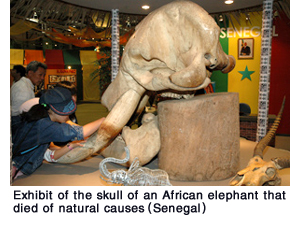 The Senegal exhibit includes the skull and tusks of an African elephant that died of natural causes, as well as a model of an afforestation project being advanced with Japan and other countries. These two exhibits are expressions of the country’s determination to protect the wildlife of Africa from poachers as well as prevent desertification of the world through international cooperation.
The Senegal exhibit includes the skull and tusks of an African elephant that died of natural causes, as well as a model of an afforestation project being advanced with Japan and other countries. These two exhibits are expressions of the country’s determination to protect the wildlife of Africa from poachers as well as prevent desertification of the world through international cooperation.The more visitors get to know about the richness and diversity of Africa’s natural environment, they are almost certain to realize the invaluableness its nature has for the future of our Earth. At every corner of this joint pavilion, there are people in charge of each country’s display area who greet visitors with a warm smile and courteously provide explanations of their exhibits. The descriptions that they provide further deeply communicate the appeal and message behind the exhibited items, while at the same time transmit the spirit of warm hospitality to visitors. There is also a restaurant where visitors can experience the unique spicy stews and various other foods of Africa. This is also a place where the grand intercultural symphony is taking place. Why not go on a delightful journey to Africa and meet its people and take a peek at its natural environment? |
![]()
![]()
 |
|
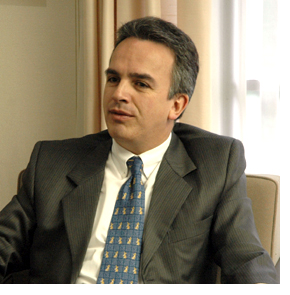 I would say that first of all, the importance of EXPO 2005 Aichi, Japan is that it presents new technologies and new, bright proposals on how to deal with common problems. Furthermore, it reiterates that we have only one world - the Earth - and that ecosystems are all integrated. There is also focus on presenting things which evoke the attention of children. I think that many children who come to EXPO 2005 will instinctively sense that this is one small world; that you need technologies and that you have to share these technologies for the benefit of humankind. This, too, is a powerful idea, and one of the characteristics that makes EXPO 2005 superb.
I would say that first of all, the importance of EXPO 2005 Aichi, Japan is that it presents new technologies and new, bright proposals on how to deal with common problems. Furthermore, it reiterates that we have only one world - the Earth - and that ecosystems are all integrated. There is also focus on presenting things which evoke the attention of children. I think that many children who come to EXPO 2005 will instinctively sense that this is one small world; that you need technologies and that you have to share these technologies for the benefit of humankind. This, too, is a powerful idea, and one of the characteristics that makes EXPO 2005 superb.Expos are a party of talents; it is a party in which many talented minds come together. We do not have to celebrate with tears or confront environmental problems with a sense that this is a losing battle. I feel that EXPO 2005 gives us the hope that the inventiveness of the human race will enable us to defeat the problems that we face today. I think that it is very significant that this kind of Expo is being held at the beginning of the 21st century. Mexico is a multicultural, multiethnic country. We are a relatively new country, less than 200 years old, but in a sense, we are also a very old country because our roots go back some 3,000 years. Mexico is the fourth largest country in the world in terms of biodiversity, and so the theme of our pavilion is, “Interweaving Diversity.” We show how the jungles, the forests, the seas, and the deserts - the four main ecosystems that exist in Mexico - have had an impact on the cultural development of the various Mexican people living there. For example, from about 2,000 years ago, the cultural manifestations of the people who were living in what we now know as Mexico tended to imitate the colors of nature; pure colors such as reds, greens and yellows. You still see this kind of color contrast in the works of modern Mexican artists such as Rufino Tamayo and Diego Rivera as well as in our ethnic costumes. We will also be presenting our diversity and multiculturalism through music, dance and other artistic presentations performed by artists, dancers, singers and so on. For example, on the Mexican National Day, visitors will be able to enjoy not only traditional performing arts, such as folklore dances and mariachi, but also arts that represent the contemporary age including a performance by Eugenia León, a female vocalist who is representative of the younger generation of Mexican artists. I have visited the pavilions of other countries, and I found it very interesting to see how different they are from the Mexican Pavilion and how each country is presenting their own cultural identity. While economic globalization is advancing today, I think that multicultural exchange, the coexistence of diverse cultures and mutual respect are some of the fundamental human values that should guide us throughout the 21st century. |
|
![]()
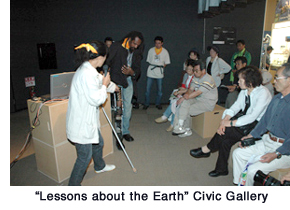 EXPO 2005 Aichi, Japan is the first world exposition in which there is citizen participation. One of the bases of their activities is the Civic Pavilion and Kaisho Plaza located in the Seto Area. The concept is “How to Love the Earth.” The meaning of this concept becomes clearly apparent when one visits the exhibit site.
EXPO 2005 Aichi, Japan is the first world exposition in which there is citizen participation. One of the bases of their activities is the Civic Pavilion and Kaisho Plaza located in the Seto Area. The concept is “How to Love the Earth.” The meaning of this concept becomes clearly apparent when one visits the exhibit site.When visiting the Civic Gallery on the second floor of the Civic Pavilion, visitors will notice an exhibition space that is filled with people. This is a forum for dialogue called “Lessons about the Earth.” The theme of this particular day was “Self-support from the Rwanda Genocide through Prosthetic Limbs.” The day’s lecturers were Gatera Emmanuel Rudasingwa, who launched this activity, and his wife Mami. Introduced through photos, etc. were how Rwandan youths and others who had lost their limbs and had sustained themselves by beggary had created soccer teams or come to Japan to learn skills related to prosthesis making. This was one way through which people were showing how to love the Earth. |
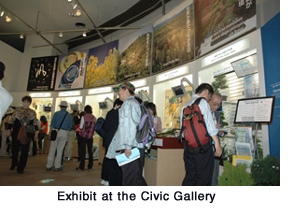 At another corner of the Civic Gallery, college students were passionately introducing a project named “Traveling Diaries Going around the World.” A theme is set per notebook and every person that receives it expresses their thoughts through words or drawings on each page. The last person to write in the notebook hands it back to the college students. 2,005 notebooks that have “drifted back” are already on exhibit here, and the number of such notebooks keeps increasing. The college students are appealing the joy and importance of believing in people and expanding the circle.
At another corner of the Civic Gallery, college students were passionately introducing a project named “Traveling Diaries Going around the World.” A theme is set per notebook and every person that receives it expresses their thoughts through words or drawings on each page. The last person to write in the notebook hands it back to the college students. 2,005 notebooks that have “drifted back” are already on exhibit here, and the number of such notebooks keeps increasing. The college students are appealing the joy and importance of believing in people and expanding the circle.Diverse projects by various citizens, such as that initiated by a woman appealing the importance of “slow life” activities by introducing community building by local governments, etc., or a project by an elderly man who uses Bonsai dwarf trees as a motif to explain the recycle-based society of rural settings, can be found here. Furthermore, visitors will find at the Civic Theater on the first floor of the Civic Pavilion, talk events, discussions and concerts initiated by citizens, NPOs, NGOs and individuals themed around “Global Dialogue,” which address issues that we face today on Earth such as those related to world peace, welfare, education and health. |
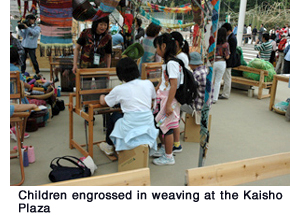 Outside of the Civic Pavilion is Kaisho Plaza. This is an area surrounded by greenery where various events are held as part of the Global Citizens’ Exchange Festival.
Outside of the Civic Pavilion is Kaisho Plaza. This is an area surrounded by greenery where various events are held as part of the Global Citizens’ Exchange Festival.There, visitors will notice the presence of many children. They enjoy themselves as they try their hand at plant dyeing using dyes from EXPO 2005 participating countries, create flowers, fruits, etc. using eco clay, or make flying toys out of bamboo at Kaisho Plaza. You will also notice families having a grand time and clapping to the fun concerts being held on stage. There are also children that are absorbed in weaving as part of the workshop that is trying to create a 2,005-meter-long piece of cloth. There are apparently children who come everyday saying, “Hi! I’m back.” One of the staff members said, “I feel like I’ve become the elderly person living next door to these children, but it makes me happy.” This workshop is supported by more than 400 volunteers and is being held every day during EXPO 2005. Making things, having fun, playing music or dancing... children who visit this area are using their bodies and souls to lean how to love the Earth. Enjoying, from the bottom of their hearts, life on Earth with others; learning how to be spiritually moved by the beautiful; getting to know the joy of making things; and communicating the happiness of such to children are just some of the various events being held through citizen participation at EXPO 2005 under the concept of loving the Earth. Find out how to love our Earth by coming here and participating in the events. For details regarding the Civic Project, please visit the Civic Project - Citizens’ Interchange Plaza & Interchange Site. |
| EXPO 2005 AICHI, JAPAN Newsletter | |
| To read past issues:Back Number | |
| Editor/Publisher: Japan Association for
the 2005 World Exposition Head Office: 1533-1 Ibaragabasama, Nagakute-cho Aichi 480-1101 Japan Nagoya Office: Nagoya Daiya II Bldg 4F, 3-15-1 Meieki Nakamura-ku, Nagoya, Aichi 450-0002 Japan Tokyo Office: Iino Bldg 8F, 2-1-1 Uchisaiwai-cho Chiyoda-ku, Tokyo 100-0011 Japan |
 |
© Japan Association for the 2005 World Exposition
